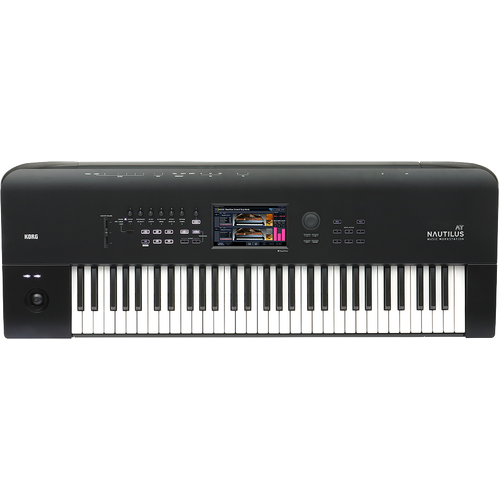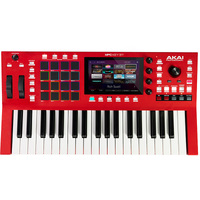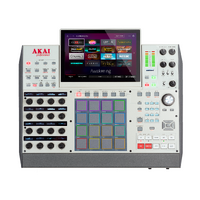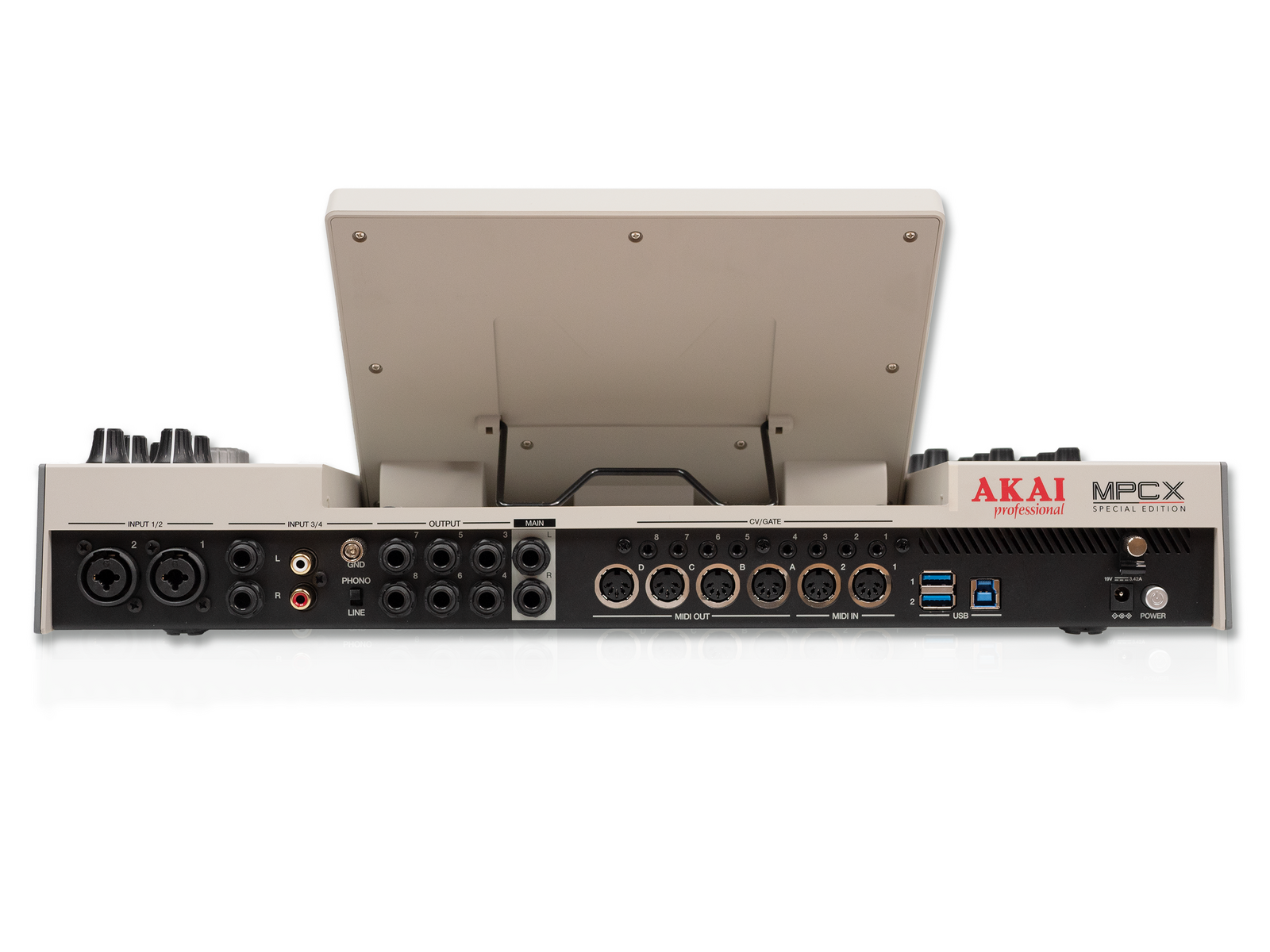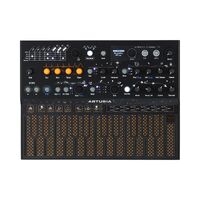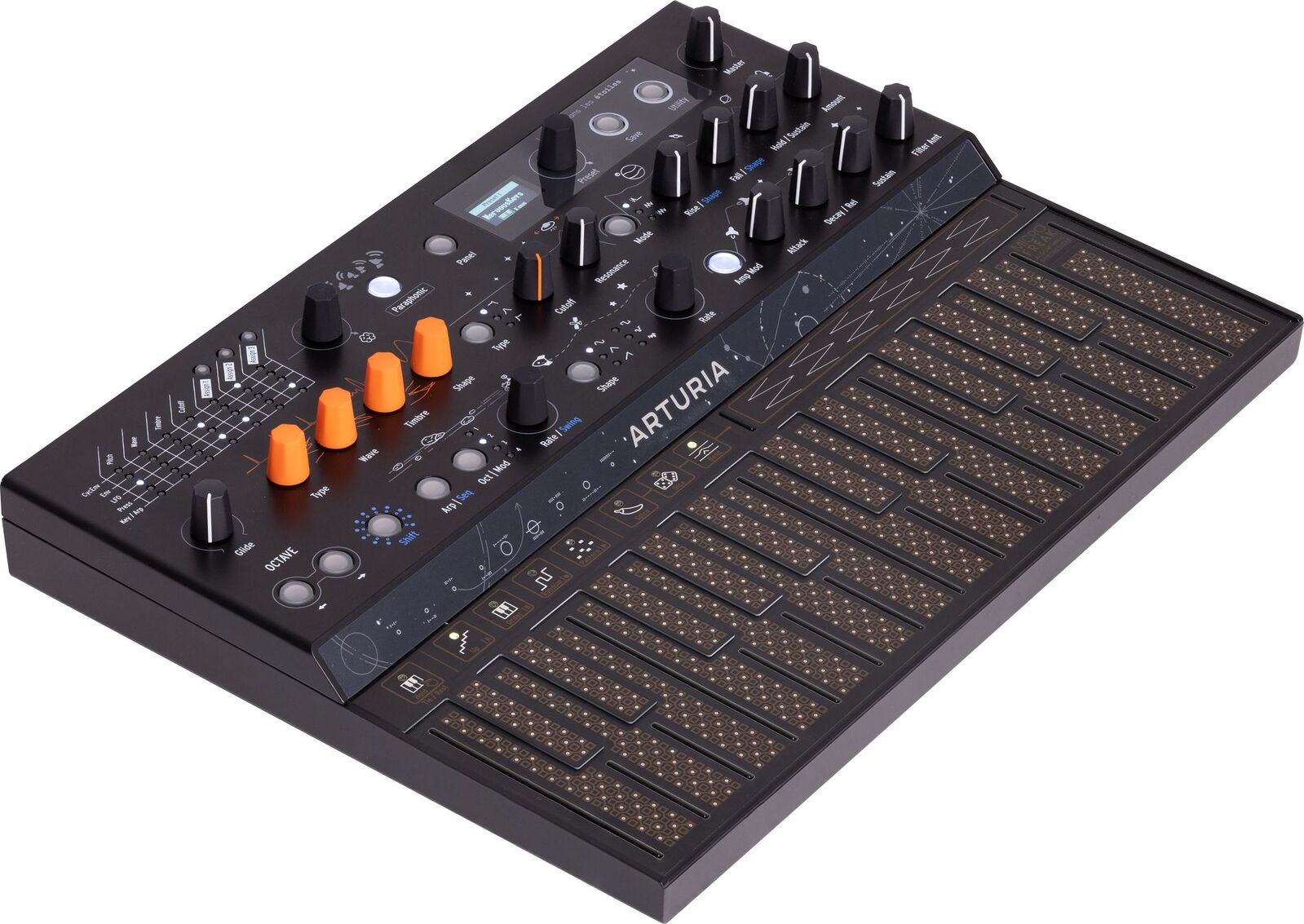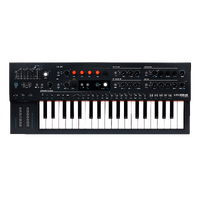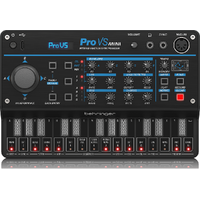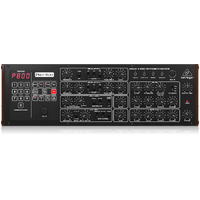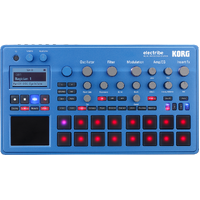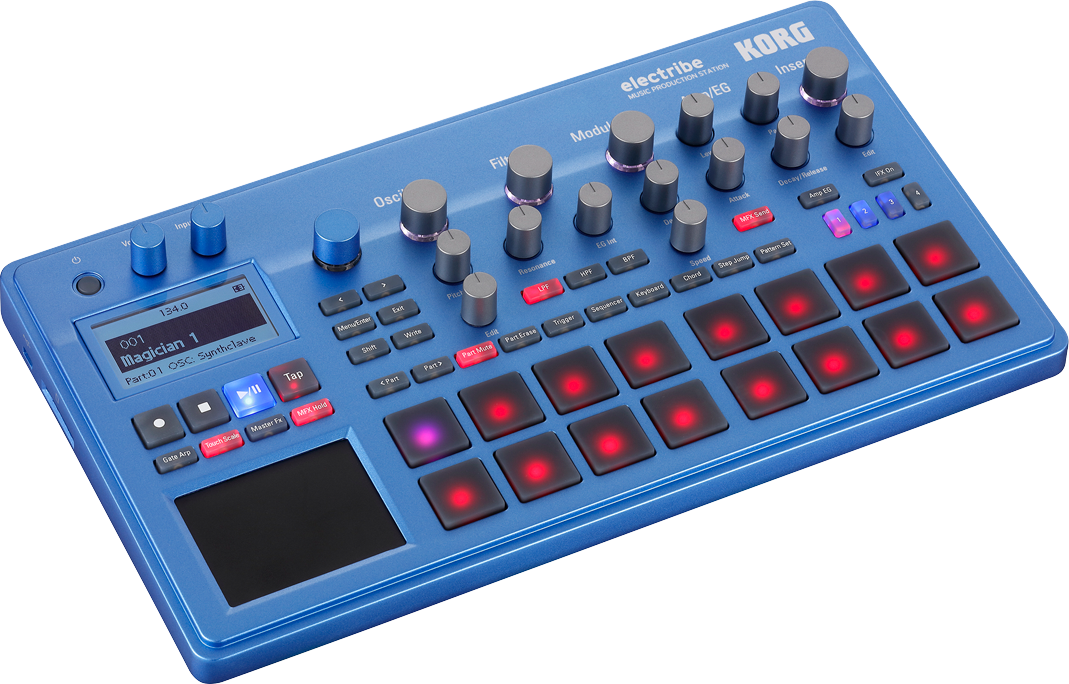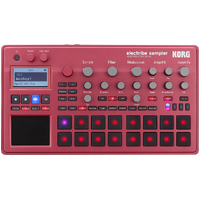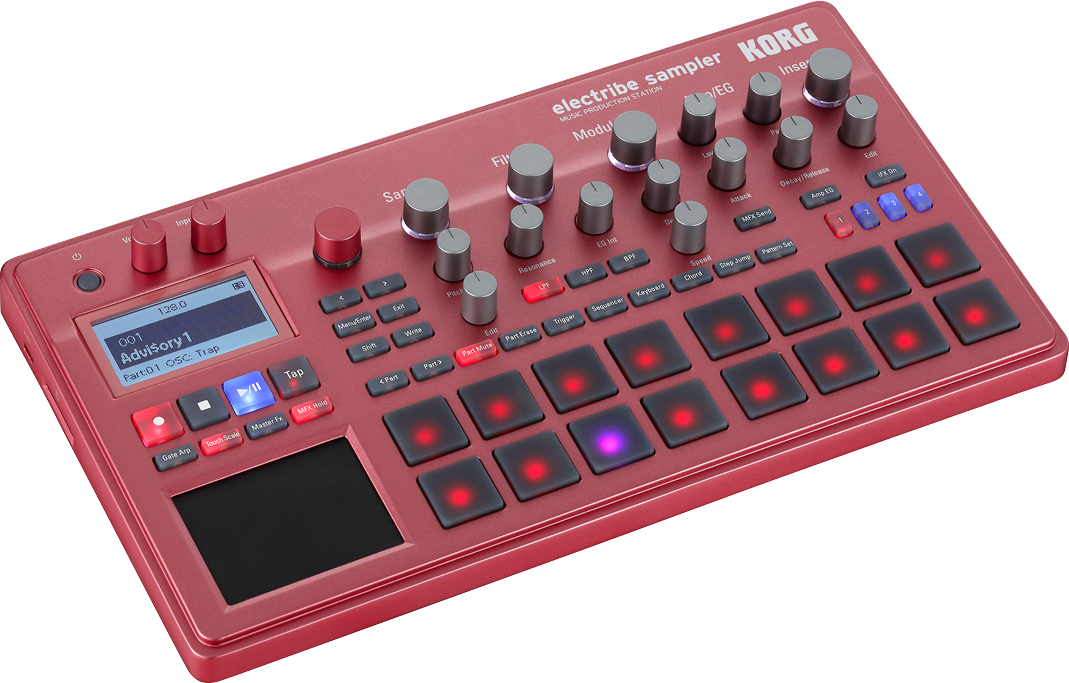Korg NAUTILUS AT 61
Performance Synth and Workstation with Aftertouch
Powering new heights of musical expression
NAUTILUS is KORG’s flagship workstation. The successor to the wildly popular KRONOS, the range now includes two new AT models. Available in 61 and 88-key versions, NAUTILUS AT introduces Aftertouch to the lineup, putting new heights of musical expression at your fingertips.
NAUTILUS AT features an expertly-tuned sound library that brings exciting aftertouch-controlled effects to the existing programs, meaning you can fully embrace the expressive capabilities of Aftertouch right out of the box.
Aftertouch, in combination with initial touch and the DYNAMICS knob (giving instant control over the changes in sound) opens a wide range of musical expression in just one instrument. Combined, these features truly unlock the full potential of nine powerful sound engines, and a vast array of other features on NAUTILUS.
NAUTILUS AT comes in two versions: an 88-key model with a premium weighted RH3 keyboard for an incredible piano feel, and a 61-key model with a light, responsive and smooth synthesizer keyboard feel.
(*) NAUTILUS-73 does not have an AT version.
Flagship model, Premium quality
NAUTILUS is manufactured in Japan to the highest levels of quality. The 88-key model uses the critically acclaimed RH-3 piano keyboard, a four-stage weighted hammer action keybed that provides an extremely realistic piano feel for even the most discerning of players. RH-3 keyboards are gradually weighted, meaning that the lower notes are heavier, and the higher notes lighter for superb playability. The 61-key NAUTILUS AT features a synthesizer keyboard with a light touch able to reproduce the most complex of performances reliably and with the smoothest feel.
As part of the wider NAUTILUS range, it’s easy to identify aftertouch-equipped models thanks to the AT mark above the NAUTILUS logo on the front panel.
Nine Synthesizer Engines, United in One Instrument
NAUTILUS harnesses nine distinct synthesizer/sound engines into a single, integrated musical instrument. Dynamic voice allocation and new technologies allow all sound engines to smoothly share a stable, enhanced hardware platform. The results are nothing less than spectacular.
SGX-2: Premium Piano
This sound generator lets you perform with the sounds of famed grand pianos such as the German piano, on which the ambience sounds can be freely modified; or the Italian grand piano, whose sound is growing rapidly in popularity over recent years. These pianos offers delicate expressiveness to capture every last nuance of the acoustic piano, with 12-step velocity-switched sound, string resonance and more.
*String resonance
With the damper pedal depressed, all of the piano strings are free to resonate. When any key is played on the piano, other strings that are pitch-related to the original key may begin to vibrate via sympathetic resonance. The SGX-2 accurately captures and recreates this sympathetic string resonance, adding an additional level of detail to the grand piano sound.
* String resonance overtones can be viewed in the string length edit screen.
EP-1: MDS Electric Piano
This dedicated electric piano sound generator realistically reproduces seven different famous electric piano sounds, with the addition of an earlier model featuring a characteristic distortion. The MDS (Multi-Dimensional Synthesis) technology eliminates the transitions between velocity-switched samples, and does away with the unnatural behavior of looped samples. Smoothly responding to the nuances of the player's touch, yet allowing your performance to reach an energetic climax, this modelled engine features an astounding dynamic range that exceeds what one might expect from digital sound generation.
For each of the seven different models, different amps, cabinets, speakers, and standard vintage effects are realistically simulated. From the samples to the touch and the effects, all aspects affecting the sound are coordinated into a single package, making this the ultimate electric piano.
CX-3: Tonewheel Organ
Tonewheel organ sound engine
The original KORG CX-3 combo organ went on sale in 1980. Loved by musicians around the world, this classic organ reappeared in 2000 as a new product with the same name, but using the latest technology. In NAUTILUS, the CX-3 engine precisely models this classic tonewheel instrument. Proprietary KORG technology has been used to perfectly reproduce the vacuum tube amp, and effects such as Vibrato/Chorus. Special attention was given to the rotary speaker effect, which lets you choose from seven types, as well as use the NAUTILUS' joystick in the X-axis to control the speed. Even the instability, fold-back, leakage, and noise of the tonewheels have been obsessively analyzed and recreated. The organ sounds heard in legendary performances—some recreated here by the original artists—are now yours for the playing. Experience these classic organ sounds, reborn for the present day.
HD-1: High Definition Synthesizer
PCM sound engine
HD stands for “High Definition” indicating the HD-1’s superior sound, starting with KORG’s proprietary low-aliasing sample playback oscillators, full-bandwidth multimode resonant filters, and extraordinarily fast & smooth envelopes and LFOs. The HD-1 is the most powerful PCM sound engine in KORG’s history, into which KORG has poured all the PCM know-how accumulated since the M1. All of KORG's acclaimed PCM sounds are painstakingly created by specialized technicians. Data that was reluctantly omitted from previous models due to limited memory has now been called back into service on the NAUTILUS. The amount of waveform memory alone might rival a PC-based sound engine. Yet the real difference is in the completely different level of quality and finish that is obvious when you play these sounds as instruments on the NAUTILUS. The finest technicians, working on the finest platform, and aiming at the finest quality: that's the HD-1.
MS-20EX: Legacy Analog Collection
Analog modeling sound engine
Packed with cutting-edge technology, NAUTILUS nonetheless has respect for the classics. The KORG MS-20 first appeared in 1978 and quickly captivated many synth fans with its rich personality marked by thick and solid sound, aggressive filters, and patching capability that provided nearly infinite possibilities for creating sound. Using KORG’s CMT (Component Modeling Technology) the MS-20EX faithfully reproduces the MS-20 while dramatically expanding its patch panel functionality. Modulate filters with audio-rate oscillators; turn audio inputs into control signals; control all of the original knobs with mod sources including additional envelopes, LFOs, and real-time controllers. It’s a tweaker’s dream. And of course, the NAUTILUS version is now majorly polyphonic.
PolysixEX: Legacy Analog Collection
Analog modeling sound engine
The Polysix first appeared in 1981, offering six-voice polyphony and program memory, and a surprisingly competitive price tag. With its self-oscillating four-pole filter, smooth analog oscillator and sub-oscillator, plus a lush Chorus/Ensemble effect, the PolysixEX extends the abilities of the original in many creative ways. The strings and pads that were such a major feature of the Polysix will be invaluable when you need the sounds of the early '80s. The classic arpeggiator built into the original Polysix is also provided. As a bonus, it’s also capable of extremely high polyphony.
AL-1: Analog Synthesizer
High-fidelity analog modeling sound engine
Feature-packed, the AL-1 is the same premium analog modeling sound engine that was first featured on the KORG OASYS, the Open Architecture Synthesis Studio back in 2005. Completely eliminating aliasing noise, and delivering the supple and fascinating sound of analog synthesis, this sound engine uses oscillator waveforms and filter morphing to generate new sounds that were unobtainable for analog synthesizers of the past.
MOD-7: Waveshaping VPM Synthesizer
VPM/FM synthesis sound engine
This sound engine uses VPM synthesis based on the VPM (Variable Phase Modulation) technology that powered two classic instruments, the Prophecy which appeared in 1995 and the Z1 which appeared in 1997 as a further evolution, and adds PCM sample playback, multi-mode filters, and external input to create a freely patchable semi-modular synthesizer. Combine Variable Phase Modulation (VPM) from KORG’s classic Prohpecy and Z1, add in some wave-shaping, a little ring modulation, mix in a few samples, and add subtractive synthesis, plus a modular patch-panel system, and you have the MOD-7. Exceptionally versatile, it offers everything from classic FM keyboards, bells and basses (including the ability to import sounds from vintage DX synths) to rhythmic soundscapes and sparkling, epic pads.
STR-1: Plucked Strings
Physical model sound engine
Based on the physical modeling know-how KORG developed over the course of many years, this struck/plucked-string physical modeling sound engine takes advantage of cutting-edge technology. This sound engine shines at producing sounds whose tone responds to your touch in ways that are difficult for a PCM sound engine to reproduce: acoustic guitar, electric guitar, harpsichord, clavinet, harp, bell, as well as ethnic instruments. It also goes much further, allowing you to synthesize and modify sounds that do not exist in reality. This is a sound engine of the future, one that allows the synthesizer programmer to construct truly new sounds.
SPECIFICATIONS
Keyboard: Natural Touch Semi Weighted*
*Supports Velocity sensitive and aftertouch.
Dimensions (W x D x H): 61 key: 1,062 x 386 x 116 mm / 41.81” x 15.20” x 4.57”
Weight: 61 key: 13.0 kg / 28.66 lb.
Tone Generator
Synthesis Types: 9
-
SGX-2: Premium Piano (Acoustic Piano)
-
EP-1: MDS Electric Piano (Electric Piano)
-
HD-1: High Definition Synthesizer (PCM)
-
AL-1: Analog Synthesizer (Analog Modeling)
-
CX-3: Tonewheel Organ (Tonewheel Organ Modeling)
-
STR-1: Plucked String (Physical Modeling)
-
MOD-7: Waveshaping VPM Synthesizer (VPM Synthesis)
-
MS-20EX: Component Modeling Technology (Analog Modeling)
-
PolysixEX: Component Modeling Technology (CMT Analog Modeling)
Maximum Polyphony*1*2:
-
SGX-2: 100 voices*3
-
EP-1: 104 voices
-
HD-1: 140 voices
-
AL-1: 80 voices
-
CX-3: 200 voices
-
STR-1: 40 voices
-
MOD-7: 52 voices
-
MS-20EX: 40 voices
-
PolysixEX: 180 voices
1: In rare cases, when a large number of processor-intensive effects are active simultaneously (for instance, more than 14 O-Verbs), polyphony may be slightly reduced.
*2: A portion of the multicore processor in NAUTILUS is devoted to generating voices, and a separate portion is devoted to generating effects. NAUTILUS dynamically allocates the voice processing power between the engines as necessary. The quoted maximum numbers of voices apply when 100% of the voice processing power is devoted to a single engine.
*3: 100 dual-stereo notes (equivalent to 400 mono voices)
Preset PCM: RAM 496 MB / DISK 2.3G (ROM 1,771 Multisamples, 3,955 Drumsamples)
Build-in Expansion PCM Libraries:
-
EXs301: German2 D Piano
-
EXs302: Italian F Piano
-
EXs303: Japanese Upright U Piano
-
EXs304: Prepared Piano
-
EXs305: Historical Keyboards
-
EXs306: Vintage Keyboards 2
-
EXs307: Strings & Synths
-
EXs308: Guitar Collection
-
EXs309: Bass Collection
-
EXs310: World Essence
-
EXs311: Background Loops
-
EXs312: SFX & Hits
-
EXs313: Found Percussions
-
EXs314: Expansion Drums
PCM RAM Capacity: Approx. 2GB *4
*4: The memory available for Sampling Mode will change based on the use of Expansion PCM libraries and User Sample Banks. Approx. 260 MB is available when shipped from the factory (When loading the file named “PRELOAD.KSC”).
Wave Sequences: 598 User memory, 377 Preload
Support for stereo multisamples, synchronization of individual notes, and tempo-based settings.
SGX-2 Program
Premium Piano:
-
Full key stereo sampling, Chromatically sampled at up to 12 velocity levels, no looping.
-
Damper resonance and mechanical noise are reproduced.
-
Una Corda sample support
PCM:
-
EXs301 – German2 D Piano
12 velocity levels, includes Ambience Piano type/samples -
EXs302 – Italian F Piano
12 velocity levels, no Una Corda samples -
EXs303 – Japanese Upright U Piano
8 velocity levels -
Exs304 – Prepared Piano
1-4 velocity levels
Piano Type: 128 (With the factory settings, the 64 varieties of EXs6: German D Piano, EXs7: Japanese C Piano, EXs12: SGX-1 Austrian D Piano, EXs17: Berlin D Piano do not produce sound. The options must be downloaded. (Those will be released at a later date.))
Oscillator Control:
-
Damper Resonance
-
Damper Noise
-
Mechanical Noise
-
Note Release
-
String Resonance
-
Una Corda
EP-1 Program
MDS Electric Piano: Tine and reed-type electric pianos powered by Multi-Dimensional Synthesis (MDS), and vintage effects.
Electric Piano Model Types: 7
-
Tine EP I Early
-
Tine EP I Late
-
Tine EP II
-
Tine EP V
-
Tine EP DMP
-
Reed EP200
-
Reed EP200A
Oscillator Control: Harmonic Sound Level, Attack Noise, Level, Release Noise Level, Attack Brightness, Hammer Width
Panel Control:
-
Tine Type
Preamp Volume, Tone (Treble, Bass), Vibrate (On/Off, Intensity, Speed), Amp/Cabinet (On/Off, Drive) -
Reed Type
Preamp Volume, Tone (Treble, Bass), Vibrate (Intensity, Speed), Amp/Cabinet (On/Off, Drive)
Effect Types: 9
Small Phase
Orange Phase
Black Phase
Vintage Chorus
Black Chorus
EP Chorus
Vintage Flanger
Red Comp
VOX Wah
HD-1 Program
Advanced Vector Synthesis: Control oscillator volumes and synthesis & effects parameters via the Vector Joystick and the tempo-synchronized Vector Envelope.
Structure:
-
Single: only OSC1, Double: OSC1 and OSC2.
-
Double mode lets you layer two completely separate synth voices, each with their own velocity-switched oscillator, dual filter, EGs, LFOs, etc.
-
Drums: One drum kit, Double Drums: Two drum kits.
Oscillators: 8 velocity zones per oscillator, with switching, crossfades and layering. Each zone can play mono or stereo Multisamples or Wave Sequences
Filters: Two multi-mode filters per voices (low-pass, high-pass, band-pass and band-reject), Four-mode filter routings (single, serial, parallel and 24dB mode)
Driver: Per voice non-linear driver and low boost circuit
EQ: Three bands, with sweep-able mid
Modulation: Three envelope generators, two LFOs per voice, common LFO, four key tracking generators, AMS (Alternate Modulation Source), two AMS mixers, Quick Layer / Split function
EXi Program Common
Advanced Vector Synthesis: Control oscillator volumes and synthesis & effects parameters via the Vector Joystick and the tempo-synchronized Vector Envelope
Modulation: Common Step Sequencer, AMS (Alternate Modulation Source), Common LFO, 2 Key Tracking Generators
EQ: Three bands, with sweep-able mid, Quick Layer / Split function
AL-1 Program
Oscillators: Ultra-low-aliasing oscillators, OSC1, OSC2, Sub-oscillator and noise generator; ring modulation, FM and Sync
Audio Input: External audio can be processed through the ring modulator, filter, driver, amp, and EQ
Filters: Two multi-mode filters (low-pass, high-pass, band-pass and band-reject) with four types of filter routings (single, serial, parallel and 24dB mode), Multi Filter mode (only Filter-A; modulatable mix of Low Pass, High Pass, Band Pass, and dry input, for creating a wide variety of unique filter types and effects)
Driver: Per-voice non-linear driver and low boost circuit
Modulation: Five Envelope generators, four per-voice LFOs, two AMS Mixers; Per-voice Step Sequencer
CX-3 Program
Tonewheel Organ Modeling: Phase-synchronous tonewheels (clean and vintage modes), percussion, key click, wheel brake
EX Mode: Four additional, user-specified drawbars, and expanded percussion
Internal Effects: Rotary speaker, vibrato/chorus, amp modeling with overdrive, 3-band EQ
Drawbar Control: Controlled via nine front-panel sliders (via Tone Adjust)
Split: Upper, Lower (even in EX mode)
Modulation: Two AMS mixers
STR-1 Program
Physically Modeled String: Includes physically modeled damping, decay, dispersion, nonlinearity, harmonics, dual pickups, and more. Most string parameters can be controlled in realtime
String Excitation: Three independent excitation sources can be used simultaneously: Pluck, Noise, and PCM. 16 preset “pluck” types, with modulatable width and randomization. Noise generator with saturation and dedicated low pass filter
-
PCM Oscillator
KORG’s ultra-low-aliasing technology, as introduced in the HD-1; 4 velocity zones per oscillator; Uses any mono Multisamples, including ROM, EXs, User Sample Bank, or Sampling Mode. Supports Virtual Memory. -
Excitation Filter
Dedicated 2-pole multimode filter for shaping the string excitation. Filter can be enabled/disabled separately for each excitation source. Low Pass, High Pass, Band Pass, and Band Reject modes
Audio Input and Feedback: Run real-time audio through the string, including feedback through effects. Modeled feedback includes modulate-able instrument-to-amp distance and orientation
Filters: Dual multi-mode filters per voice; Single, Serial, Parallel (with split stereo output), and 24dB (4-pole) configurations. Low Pass, High Pass, Band Pass, and Band Reject modes
Multi Filter Mode (Filter A only)
Modulatable mix of Low Pass, High Pass, Band Pass, and dry input, for creating a wide variety of unique filter types and effects
Modulation: 5 Envelopes, 4 per-voice LFOs, 2 Key Track generators, String Tracking generators, 4 AMS Mixers
MOD-7 Program
Waveshaping VPM Synthesizer: Combines Variable Phase Modulation (VPM), Waveshaping ring modulation, PCM sample playback, and subtractive synthesis; Able to convert-load SYX files
Oscillators:
-
6 VPM/Waveshaper/Ring Modulation Oscillators
Phase and modulatable pitch per oscillator. 101 Waveshaper tables plus modulatable Drive and Offset. Use as oscillators, or as Waveshapers or Ring Modulators for other signals -
PCM Oscillator
KORG’s ultra-low-aliasing technology, as introduced in the HD-1. 4 velocity zones per oscillator.Uses any mono Multisamples, including ROM, EXs, User Sample Bank, or Sampling Mode. Supports Virtual Memory -
Noise Generator (With saturation and low-pass filter function)
Audio Tnput: Run real-time audio through the VPM Oscillators and filters.
Filters: Dual multi-mode filters per voice. (Low Pass, High Pass, Band Pass, and Band Reject modes) , Two types of filter looping (Parallel and 24 dB “4-Pole”)
-
Multi Filter mode (Filter A only)
Modulatable mix of Low Pass, High Pass, Band Pass, and dry input, for creating a wide variety of unique filter types and effects
Patch Panel: Supports both preset algorithm (78 types) selection and free patching.Three 2-in, 1-out mixers for scaling and merging audio, fully modulatable, with phase inversion. Main 6-input stereo mixer, with modulatable pan and volume, plus phase inversion
Modulation: 10 Envelopes, 4 per-voice LFOs, 9 Key Tracking generators, Per-voice Step Sequencer, 4 standard AMS Mixers plus 4 simple AMS Mixers
MS-20EX Program
Oscillators: Ultra-low-aliasing oscillators; VCO1, VCO2, Ring Mod, Pink and White Noise Generator
Audio Input: Run real-time audio through the synthesis engine and ESP (External Signal Processor)
Filters: 12dB/octave High Pass and Low Pass self-resonant filters
-
ESP section
24dB/octave Low Cut and High Cut filters, available per voice.
Patch Panel: Patchable audio and modulation, at audio rates
Patch Points:
-
Keyboard
Keyboard CV Out, Keyboard Trigger Out, VCO1+VCO2 CV In, VCO2 CV In -
VCO
VCO1+VCO2 External Frequency Control In, VCO1 Out, VCO2 Out -
VCF
External Signal In, External HP Filter Cutoff Frequency Control In, External LP Filter Cutoff Frequency Control In, HPF Out, LPF In, LPF Out -
VCO+VCF
Total External Modulation In -
VCA
External Initial Gain Control In, VCA In -
EG
EG1 Envelope Signal Normal Out, EG1 Envelope Signal Reverse Out, EG1+EG2 Trigger In, EG1 Trigger In, EG2 Envelope Signal Reverse Out -
MG
Triangle Out, Rectangle Out -
Noise Generator
Pink Noise Out, White Noise Out -
Sample and Hold
Clock Trigger In, Sample Signal In, S/H Out -
Modulation VCA
Control Voltage In, Signal In, Signal Out -
Manual Controller
Control Wheel Out, Momentary Switch -
ESP
Signal In, AMP Out, BPF In, BPF Out, F-V CV Out, Envelope Out, Trigger Out -
Others
EXi Audio In, Mixer 1 In, Mixer 1 Out, Mixer 2 In, Mixer 2 Out
ESP (External Signal Processor):Use incoming audio as a trigger and/or CV source
Modulation: Original DAR (Delay, Attack, Release) and HADSR (Hold, Attack, Decay, Sustain, Release) EGs 1 &2, Original MG (with MIDI sync), Sample-and- Hold, MVCA, NAUTILUS: 4 additional multi-stage Envelopes, 4 additional per-voice LFOs, and 4 AMS Mixers.
PolysixEX Program
Oscillators:
-
VCO
Saw, Pulse, PWM -
Sub Oscillator
Off, 1 octave below, 2 octaves below
Filter: 24dB(4-Pole) Octave Low Pass self-resonant filter
Effects: Integrated Polysix Chorus, Phaser, and Ensemble
Arpeggiator: Integrated MIDI-synced arpeggiator, with adjustable Range, Mode, and Latch
Modulation:
-
Polysix
Original ADSR EG and MG (with MIDI sync). -
NAUTILUS
2 additional multi-stage Envelopes, 2 additional per-voice LFOs, and 4 AMS Mixers.
Combination
Number of Timbres, Master Keyboard Functionality: 16 Maximum. Keyboard and velocity splits, layers, and crossfades of up to 16 Programs and/or external MIDI Devices. The tone adjust parameter function lets you modify program settings, and the master keyboard function lets you control external MIDI devices.
Advanced Vector Synthesis: Control oscillator volumes and synthesis & effects parameters via the Vector Joystick and the tempo-synchronized Vector Envelope. Quick Layer / Split function
Drumkit
Assignable stereo/mono samples with 8 velocity zones per oscillator (with crossfade functions)
Number of Programs/Combinations/Drum kits
User Memory Programs: 2,560 (1,920 [1,280 HD-1+640 EXi] come preloaded)
User Memory Combinations: 1,792 (256 come preloaded)
User Memory Drum Kits: 264 (104 come preloaded), 256 GM Level2 preset programs + 9 GM Level 2 drum preset programs
Set List
Number of Set Lists/Slots:
-
128 set lists, 128 slots per set list
-
Each set list provides a 9-band graphic EQ, and a Tone Adjust function that allows program settings to be adjusted
-
Transpose setting
-
Hold Time setting of Smooth Sound Transition (SST) supported for each slot
Sampling
System: Open Sampling System (resampling, In-Track sampling)
Bit Depth/Sampling Frequency: RAM: 16-bit/48 kHz stereo/mono sampling
DISK: 16 or 24-bit/48 kHz
Sampling Time: RAM: Depends on the amount of available PCM RAM
DISK: Maximum 80 minutes stereo (879MB: 16bit)
Sample Locations: 16,000 samples/4,000 multisamples (128 indexes per multisample)
Formats: KORG format, AKAI S1000/S3000 data (with advanced Program parameter conversion); SoundFont 2.0, AIFF, and WAVE formats
Editing: Time Stretch, Time Slice, Crossfade Loop, and other standard editing features.
Effects
Insert Effects: 12 Stereo in / stereo out
Master Effects: 2 Stereo in / stereo out
Total Effects: 2 Stereo in / stereo out
Timbre EQ: One 3-band EQ for each timbre/track
Effect Types: 197
Modulation: Dynamic Modulation and Common LFO
Effects Control Busses: Stereo side-chaining for compressors, gates, vocoders, etc
Effect Presets: Total 783 preset, Maximum 32 per 1 effect (Preset User)
Arpeggiator
Arpeggiator Modules: One module in Program mode, two modules in Combination and Sequencer modes
Arpeggio Pattern: 5 presets + ARP A 2,048 slots (1,593 come Preload) + ARP B 128 slots
Controllers: On/Off, Latch, Gate, Velocity, Length, Swing, Tempo
Drum Track
Preset Patterns: 1,272 (common with the preset patterns of the MIDI sequencer)
User Patterns: 1,000. Patterns created in Sequencer mode can be converted to drum track user patterns. Trigger Mode/ Sync / Zone / Swing, Drum SD, Tempo settings can be specified.
Sequencer / HDR
Tracks: 16-track MIDI sequencer + 16-track hard disk recorder + 1 master track.
Number of Songs: 200
Resolution: 1/480
Tempo: 40.00 – 300.00 (1/100 BPM resolution)
Maximum Memory: 400,000 MIDI events or 300,000 audio events
MIDI Tracks: 16 tracks plus the master track, 697 preset / 100 user patterns (per song), 18 preset/16 user template songs,
Audio Tracks:
-
16-track playback, 4-track simultaneous recording, WAV file format 16bit/24bit
-
Maximum Single-file Recording Time (mono): 80 minutes
-
Automation: Volume, Pan, EQ, and Send1/2
-
10,000 regions (max.)
-
Event Anchors, BPM Adjust
Other Functions: RPPR (Realtime Pattern Play and Record): 1 Pattern set per song
General:
Disk Mode: Load, save, utility, data filer function (save/load MIDI System Exclusive data), CD-R/RW (UDF format read/write), ISO9660 Level 1.
Controllers: Joystick, Switches 1 & 2, Arpeggiator Control: On/Off, Latch, Gate, Velocity, Length, Swing, Tempo, DRUM TRACK: On/Off, Swing, Drum SD, Tempo
Display: TouchView graphical user interface, 7 inch color TFT, WVGA (800 x 480 dots), adjustable brightness
Principal Specifications
Frequency Response: 20Hz-22kHz, +/-1.0dB, 10k Ω load
THD+N: 20Hz-22kHz, 0.01%, 10k Ω load (typical)
S/N: 95dB (typical)
Dynamic Range: 95dB (typical)
Crosstalk: 95dB, at 1kHz (typical)
Outputs:
L/MONO, R, Individual 1-4
1/4” TRS Balanced
Output Impedance: 350 Ω Stereo; 175 Ω Mono (L/MONO Only),
Nominal Level: +4.0 dBu,
Maximum Level: +16.0 dBu (when load impedance is 600 Ω or greater)
MAIN VOLUME slider controls only AUDIO OUTPUT (MAIN) L/MONO and R
Headphones
1/4” stereo phone jack
Output impedance: 33 Ω,
Maximum Level: 60+60 mW (when load impedance is 33 Ω),
MAIN VOLUME knob (link with AUDIO OUTPUT (MAIN))
USB-B
24-bit, Sample Rate: 48 kHz, 2 channels
(Digital output of the same signals as AUDIO OUTPUT (MAIN) L/MONO and R)
Inputs:
Audio Inputs 1 and 2
1/4” TRS Balanced
Input Impedance: 10 kΩ
Nominal Level: LINE +4 dBu
Maximum Level: LINE +16 dBu
Nominal Level: MIC –22 dBu
Maximum Level: MIC -10 dBu
Source Impedance: 600 Ω
USB-B
24-bit, Sample Rate: 48 kHz, 2 channels
Control Inputs: Damper pedal (half damper supported), Assignable switch, Assignable pedal
MIDI: In, Out, Thru
USB
USB A (TYPE A)
For connection to external USB devices (QWERTY keyboards, MIDI controllers, ethernet adaptors, and storage)
USB B (TYPE B)
MIDI/audio interface, MIDI: 1 (16 channel) input / 1 (16 channel) output, Audio: 2 channel input / 2 channel output
*2 USB high-speed ports (supports 480Mbps)Disk Drives60 GB SSD (2.5”)
Power Supply: AC power supply terminal, Power switch
Power Consumption: 40 W
Accessories: AC cord, Quick Start Guide
Optional extras:
XVP-20: Expression/Volume Pedal
EXP-2: Foot Controller
DS-1H: Damper Pedal
PS-1: Pedal Switch
PS-3: Pedal Switch
For more information, click here to visit the manufacturers website.


